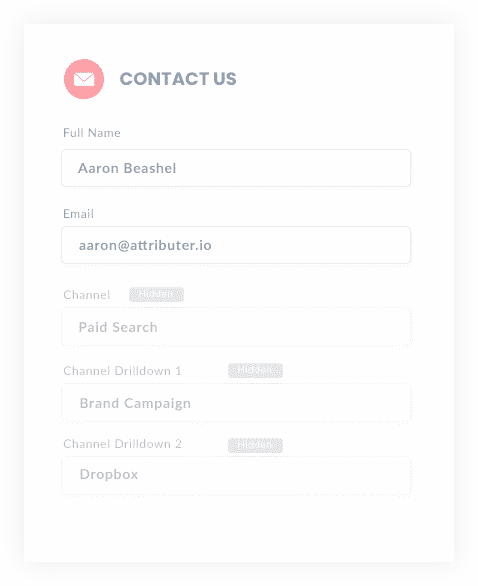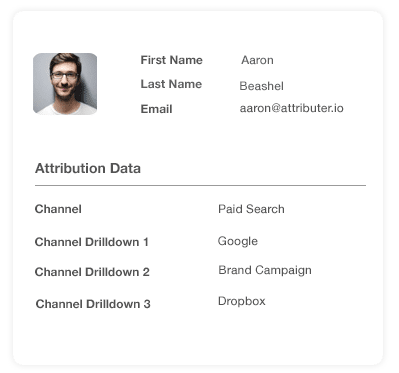The easiest way to get UTM Parameters into Perfex
Learn the easiest way to get UTM parameters into Perfex so that you can identify what marketing tactics are generating leads and customers

As a marketer looking to accelerate growth, you spend countless hours or days setting up effective marketing channels to generate leads you can nurture into sales.
But how is the success of each lead generation strategy measured? How are you to know where your focus and budget should be directed?
Imagine being able to easily track every lead and opportunity in Perfex CRM and then run reports that reveal exactly which of your marketing campaigns, content & channels are working.
In this article, we'll show you how to do exactly that.
What is Attributer?
Attributer is a a small piece of code that you place on your site that look sat technical information about a user that comes to your site (HTTP referrer information, UTM parameters, device, etc.)
It then uses this technical information to categorize each user into channels like Paid Search, Organic Search, Paid Social, etc., Attributer then saves this information in the user's browser in the form of a cookie.
When a user submits a form Attributer, in the background, adds those UTM parameter values to the form submission.
This data, along with the information entered into the form (like the lead's name, email, company, etc) is then sent into Perfex.
From there, you can then run reports in Perfex (or in other analytics tools connected to Perfex) that show you where your leads, customers & revenue are coming from.
4 steps for capturing UTM parameters in Perfex
Using Attributer to capture UTM parameters in Perfex is easy. Here's how to do it in 4 easy steps:
1. Add UTM variables to your ads

Start by using UTM parameters behind each of your paid ads and marketing campaigns. This includes ads on social media platforms like LinkedIn, Facebook, Twitter, Instagram, or behind ads on search engines like Yahoo, Bing and Google. Also, to get a complete and total overview of your marketing efforts, consider adding UTM parameters in trade publications, email campaigns, advertisements, etc.
2. Add hidden fields to your forms

Next, take a look at your lead capture forms. These are going to be any forms you use to capture leads like contact forms, email signups, etc.
From here, you are going to add hidden fields to these forms. Hidden fields don't appear to the user but can be seen and captured by Attributer to gather data.
Here are the hidden fields you need to add to your forms:
- Channel
- Channel Drilldown 1
- Channel Drilldown 2
- Channel Drilldown 3
- Landing Page
- Landing Page Group
If you are using Perfex's Web to Lead forms then these hidden fields can be added to those forms. Alternatively, if you are using a third party form building tool (like Gravity Forms, WPForms, Typeform, etc) you can add the hidden fields to those very easily.
3. Attributer automatically completes the hidden fields with UTM data

Now that you have the six hidden fields added to your forms, Attributer will write the UTM parameters into the form fields when a form is submitted.
So, how does Attributer do this? Let's take a look at an example to understand it better.
Imagine a user searches for "ways to share large files" and see's an ad for Dropbox at the top of the search results.
With their interest piqued, the user may click on the ad and get taken to a Dropbox lead capture page to fill out a form to have an opportunity for a demo.
Attributer will then complete your hidden fields as follows:
- Channel = Paid Search
- Channel Drilldown 1 = Google
- Channel Drilldown 2 = Brand Campaign
- Channel Drilldown 3 = Dropbox
From here, Attributer will then track the page the user has landed on and populate those fields as well.
If we use the example from above, the fields would look something like this:
- Landing Page = www.dropbox.com/features/share
- Landing Page Group = Features
4. UTM parameters are passed into Perfex

After submitting your form, the UTM parameters captured by Attributer are passed into Perfex
Once inside Perfex, you can then run reports that show how many leads you are getting from each of your campaigns, how many of them are converting into Customers, how much revenue each campaign is generating and more.
Why using Attributer is better than capturing raw UTM parameters
So, you may be thinking that there are other tools available that send UTM parameters into Perfex, so why use Attributer?
Attributer doesn't only capture raw UTM parameters. It does a lot more, including:
1. Captures all traffic
Attributer captures and saves all incoming traffic sources in Perfex, even for users who landed on a page without UTM parameters.
This means that Attributer also captures information on people who comes from organic channels like Organic Search, Organic Social, Referral, etc.
This gives you a full view of where all your leads are coming from, not just the one's coming from your paid campaigns.
2. Remembers data across pageviews
Most other UTM capturing software out there requires that the UTM parameters are on the same page where the user completes the form in order for the UTM parameters to be passed into Perfex.
So if someone was to land on your 'Home' page from your ad but then fill out a form on your 'Contact Us' page, the UTM parameters would be lost.
But with Attributer, this isn't the case.
Attributer stores the data about where a particular visitor came from in a cookie, which means that the data is passed through to Perfex regardless of what page the user lands on or completes your form on.
3. Provides cleaner data
Attributer gives you a cleaner, more organized data. One of the problems with capturing UTM parameters raw is that you inevitably end up with loads of messy data that can make Marie Kondo cry.
As an example, imagine some of your Twitter campaigns are tagged with UTM_Source=Twitter.com (capital T), others with UTM_Source=twitter (lowercase, no domain), and others with UTM_Source=tw.
When you run reports in Perfex with just these raw UTM parameters to see how many leads your Twitter campaigns have brought you, you get three different sources that you would then have to stitch together.
With Attributer, you don't have to deal with this because it takes the possibility of capitalization and other inconsistencies into account, and will ascribe leads to Paid Social.
4. Captures landing page data as well
Attributer captures the initial landing page and subdirectory (or category) so that you can drill down into your analytics.
For example, if the landing page were attributer.io/blog/capture-utm-parameters, Attributer would record both the page (/capture-UTM-parameters) and subdirectory (/blog/).
This allows you to see how certain content on your site is performing (I.e. Your blog). You can also look further into individual blog posts to determine which articles attracted the most valuable leads.
Wrap up
As you can see, Attributer is more than a UTM parameter capturing tool. Attributer does a lot of heavy lifting behind the scenes to ensure you have the data you need to make better business decisions.
Not only does Attributer capture leads with UTM parameters, but ALL your incoming traffic data. In addition, Attributer cleans your data, so it's more accurate when it comes to running reports.
Ready to experience the power of Attributer? Start with a free trial to see if Attributer is right for you.
Get Started For Free
Start your 14-day free trial of Attributer today!

About the Author
Aaron Beashel is the founder of Attributer and has over 15 years of experience in marketing & analytics. He is a recognized expert in the subject and has written articles for leading websites such as Hubspot, Zapier, Search Engine Journal, Buffer, Unbounce & more. Learn more about Aaron here.
